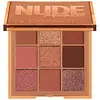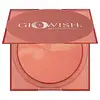What's inside
What's inside
 Key Ingredients
Key Ingredients

 Benefits
Benefits

No benefits
 Concerns
Concerns

 Ingredients Side-by-side
Ingredients Side-by-side

Talc
AbrasiveMica
Cosmetic ColorantZinc Stearate
Cosmetic ColorantDimethicone
EmollientNylon-12
Octyldodecyl Stearoyl Stearate
EmollientHydrogenated Polyisobutene
EmollientIsononyl Isononanoate
EmollientSilica
AbrasivePhenoxyethanol
PreservativeEthylhexylglycerin
Skin ConditioningTocopheryl Acetate
AntioxidantCaprylyl Glycol
EmollientCI 77891
Cosmetic ColorantIron Oxides
Calcium Sodium Borosilicate
Phenyl Trimethicone
Skin ConditioningTridecyl Trimellitate
EmollientEthylhexyl Palmitate
EmollientTin Oxide
AbrasiveCI 77491
Cosmetic ColorantCI 19140
Cosmetic ColorantPolymethylsilsesquioxane
Titanium Dioxide
Cosmetic ColorantCI 75470
Cosmetic ColorantCI 16035
Cosmetic ColorantSynthetic Fluorphlogopite
CI 77742
Cosmetic ColorantCI 77510
Cosmetic ColorantTalc, Mica, Zinc Stearate, Dimethicone, Nylon-12, Octyldodecyl Stearoyl Stearate, Hydrogenated Polyisobutene, Isononyl Isononanoate, Silica, Phenoxyethanol, Ethylhexylglycerin, Tocopheryl Acetate, Caprylyl Glycol, CI 77891, Iron Oxides, Calcium Sodium Borosilicate, Phenyl Trimethicone, Tridecyl Trimellitate, Ethylhexyl Palmitate, Tin Oxide, CI 77491, CI 19140, Polymethylsilsesquioxane, Titanium Dioxide, CI 75470, CI 16035, Synthetic Fluorphlogopite, CI 77742, CI 77510
Mica
Cosmetic ColorantSilica
AbrasiveCetearyl Ethylhexanoate
EmollientZinc Stearate
Cosmetic ColorantDimethicone
EmollientDodecane
PerfumingRosa Damascena Flower Oil
MaskingCapsicum Annuum Extract
MaskingButyrospermum Parkii Butter
Skin ConditioningHelianthus Annuus Seed Oil
EmollientEthylhexylglycerin
Skin ConditioningTocopherol
AntioxidantGlycerin
HumectantSqualene
EmollientCaprylic/Capric Triglyceride
MaskingC30-45 Alkyl Dimethicone
Skin ConditioningPhenylisopropyl Dimethicone
Skin ConditioningDimethiconol
EmollientDiethylhexyl Syringylidenemalonate
Skin ProtectingTriethylhexanoin
MaskingCetyl PEG/PPG-10/1 Dimethicone
EmulsifyingSucrose Acetate Isobutyrate
Sorbitan Sesquioleate
EmulsifyingBeta-Sitosterol
Emulsion StabilisingXanthan Gum
EmulsifyingCitric Acid
BufferingSodium Benzoate
MaskingSodium Salicylate
PreservativeCitronellyl Methylcrotonate
MaskingCI 15850
Cosmetic ColorantCI 16035
Cosmetic ColorantCI 19140
Cosmetic ColorantIron Oxides
Titanium Dioxide
Cosmetic ColorantMica, Silica, Cetearyl Ethylhexanoate, Zinc Stearate, Dimethicone, Dodecane, Rosa Damascena Flower Oil, Capsicum Annuum Extract, Butyrospermum Parkii Butter, Helianthus Annuus Seed Oil, Ethylhexylglycerin, Tocopherol, Glycerin, Squalene, Caprylic/Capric Triglyceride, C30-45 Alkyl Dimethicone, Phenylisopropyl Dimethicone, Dimethiconol, Diethylhexyl Syringylidenemalonate, Triethylhexanoin, Cetyl PEG/PPG-10/1 Dimethicone, Sucrose Acetate Isobutyrate, Sorbitan Sesquioleate, Beta-Sitosterol, Xanthan Gum, Citric Acid, Sodium Benzoate, Sodium Salicylate, Citronellyl Methylcrotonate, CI 15850, CI 16035, CI 19140, Iron Oxides, Titanium Dioxide
Ingredients Explained
These ingredients are found in both products.
Ingredients higher up in an ingredient list are typically present in a larger amount.
Ci 16035 is a synthetic dark-red dye. This dye is created from an acid called Allura red AC, an azo dye.
Azo dyes need to be purified thoroughly before use. This makes them more stable and longer lasting.
This dye is commonly used in foods, approved by both the FDA and EFSA.
Learn more about CI 16035CI 19140 is also known as Tartrazine. Tartrazine is a synthetic dye used in cosmetics, foods, and medicine to add a yellow color.
Tartrazine is created from petroleum and is water-soluble.
Some people may experience allergies from this dye, especially asthmatics and those with an aspirin intolerance.
Learn more about CI 19140Dimethicone is a type of synthetic silicone created from natural materials such as quartz.
What it does:
Dimethicone comes in different viscosities:
Depending on the viscosity, dimethicone has different properties.
Ingredients lists don't always show which type is used, so we recommend reaching out to the brand if you have questions about the viscosity.
This ingredient is unlikely to cause irritation because it does not get absorbed into skin. However, people with silicone allergies should be careful about using this ingredient.
Note: Dimethicone may contribute to pilling. This is because it is not oil or water soluble, so pilling may occur when layered with products. When mixed with heavy oils in a formula, the outcome is also quite greasy.
Learn more about DimethiconeEthylhexylglycerin (we can't pronounce this either) is commonly used as a preservative and skin softener. It is derived from glyceryl.
You might see Ethylhexylglycerin often paired with other preservatives such as phenoxyethanol. Ethylhexylglycerin has been found to increase the effectiveness of these other preservatives.
Mica is a naturally occurring mineral used to add shimmer and color in cosmetics. It can also help improve the texture of a product or give it an opaque, white/silver color.
Serecite is the name for very fine but ragged grains of mica.
This ingredient is often coated with metal oxides like titanium dioxide. Trace amounts of heavy metals may be found in mica, but these metals are not harmful in our personal products.
Mica has been used since prehistoric times throughout the world. Ancient Egyptian, Indian, Greek, Roman, Aztec, and Chinese civilizations have used mica.
Learn more about MicaSilica, also known as silicon dioxide, is a naturally occurring mineral. It is used as a fine, spherical, and porous powder in cosmetics.
Though it has exfoliant properties, the function of silica varies depending on the product.
The unique structure of silica enhances the spreadability and adds smoothness, making it a great texture enhancer.
It is also used as an active carrier, emulsifier, and mattifier due to its ability to absorb excess oil.
In some products, tiny microneedles called spicules are made from silica or hydrolyzed sponge. When you rub them in, they lightly polish away dead skin layers and enhance the penetration of active ingredients.
Learn more about SilicaTitanium dioxide is a mineral UV filter widely used in sunscreens and cosmetics.
It is one of only two UV filters officially classified as “mineral” by regulatory agencies, the other being zinc oxide.
Titanium dioxide provides broad-spectrum protection mostly in the UVB and UVAII range, with some protection in the UVAI range.
While its UVA protection isn’t as strong as zinc oxide’s, the difference is minor.
A common myth is that mineral UV filters reflect UV light. However, modern research shows titanium dioxide absorbs UV radiation like chemical filters (~95% absorption & 5% reflection).
Thanks to its non-irritating nature, titanium dioxide is suitable for sensitive, acne-prone, or redness-prone skin. It is unlikely to cause "eye sting" like other sunscreen ingredients.
A major drawback of this ingredient is its white cast and thick texture. This is why mineral sunscreens often leave a white cast and are less cosmetically elegant than chemical/hybrid sunscreens.
To improve white cast and spreadability, micronized or nano-sized titanium dioxide is often used.
There are ongoing concerns surrounding nano-titanium oxide's impact on marine ecosystems.
There is no conclusive evidence that any form of titanium oxide (or any other sunscreen ingredients) will cause harm to marine ecosystems or coral reefs. The science is still developing but many consumers are keeping a close eye on this issue.
Please note, many destinations have reef-safety sunscreen rules. For instance, the U.S. Virgin Islands advises all visitors to use non-nano mineral sunscreens.
Nano mineral sunscreens once raised safety concerns about absorption into skin.
Extensive research has shown that they do not penetrate healthy or damaged skin; they remain safely on the surface and the top layer of dead skin (stratum corneum).
You'll likely find titanium dioxide bundled with alumina, silica, or dimethicone. These ingredients help make titanium dioxide highly photostable; this prevents it from interacting with other formula components under UV light.
Learn more about Titanium DioxideZinc Stearate is the metal salt of stearic acid. It is a white solid used to bind, thicken, and lubricate products.
This ingredient is common in powder makeup, where it helps keep the powder together.
Zinc Stearate is hydrophobic and repels water.
This ingredient can be sourced from non-animal or animal sources. It is best to reach out to the brand to see where they source this ingredient from.
Learn more about Zinc StearateThis ingredient is a combination of red, black, and yellow iron oxide pigments. This combination of colors is usually found in foundation, because it results in a "skin" color.